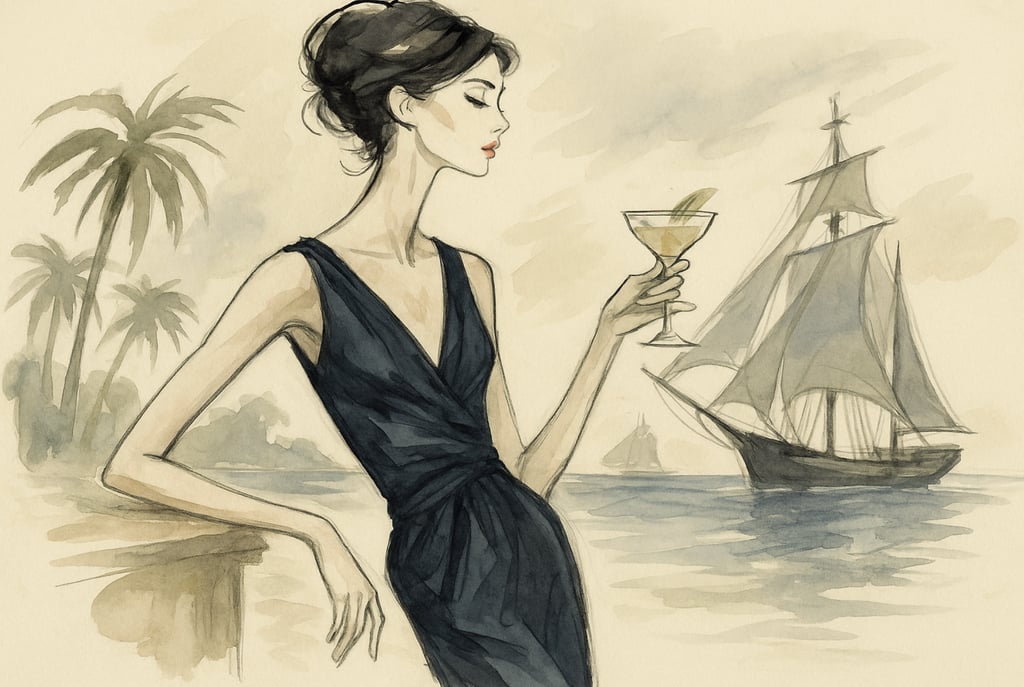What Pirates Really Drank in the Tropics: The Survival Secret of Grog
What did pirates really drink? Discover the history of grog—a mix of rum, lime juice, and water that kept sailors alive, healthy, and in line during the golden age of piracy.
FOOD HISTORY & TRADITIONS


When we picture pirates, we see them in popular culture swigging rum straight from a bottle, staggering across a deck with a bottle clenched in one hand and a sword in the other. It’s a fun image, but like much of pirate lore, it’s not entirely true. While pirates certainly drank rum, their most common—and essential—drink was a mixture called grog.
Far from a pure indulgence, grog was a life-saving concoction. It kept crews hydrated, prevented deadly diseases like scurvy, and even helped maintain order on the ship. For pirates and sailors alike, it was less about drunken debauchery and more about survival in the sweltering tropics and on the endless sea.
Why Pirates Needed More Than Water
Life at sea in the 17th and 18th centuries was harsh. Freshwater stored on ships quickly turned foul in the heat, taking on algae and a stagnant taste. Drinking it straight was unpleasant and often unsafe, as bacteria and parasites could multiply in barrels over long voyages.
Rum, abundant in the Caribbean thanks to the sugar trade, became the preferred solution. It could be mixed with spoiled water to make it palatable, and its alcohol content killed off some harmful microbes. But pure rum posed its own dangers—crews drinking it undiluted often became unruly, leading to fights, accidents, and even mutinies.
To solve both problems, captains began mixing rum with water in carefully measured portions. This diluted drink became grog, and it quickly became the standard ration not just for pirates, but for the Royal Navy and merchant sailors as well.
Lime Juice: Fighting the Curse of Scurvy
The other critical component of grog—when supplies allowed—was citrus juice, especially lime. Long voyages left sailors with limited access to fresh fruits and vegetables, leading to scurvy, a devastating disease caused by vitamin C deficiency. Symptoms included swollen gums, weakness, open sores, and, if untreated, death.
Adding lime juice to grog became a breakthrough in naval health. The citrus not only added flavour but provided enough vitamin C to keep scurvy at bay. By the 18th century, the Royal Navy had adopted the practice widely, which gave British crews a significant advantage over their rivals. Pirates, who often captured or raided ships, picked up the habit, using whatever citrus they could find in Caribbean markets or plunder.
This innovation earned British sailors the nickname “limeys,” a term that stuck long after grog itself faded from naval life. For pirates, the mix of lime and rum meant not only a more pleasant drink but a better chance of surviving long, sun-scorched journeys.
Keeping the Crew in Line
Grog wasn’t just about survival—it was also a form of control. Straight rum led to heavy intoxication, which could spark brawls and undermine discipline aboard a ship. Diluting rum with water stretched rations further, kept sailors moderately content, and reduced the chaos that pure spirits often caused.
On naval ships, the grog ration was carefully controlled, issued at set times each day. Pirates were looser in their habits, but even they found grog preferable to unregulated drinking. It became part of the rhythm of shipboard life, a daily ritual that balanced morale and functionality.
Some captains even added a spoonful of sugar or spices like nutmeg to the mix when supplies allowed, turning grog into a rudimentary punch. This touch of sweetness helped disguise the taste of stale water and gave the drink a celebratory feel, even if it was primarily a tool for survival.
Fun Fact: The Word “Grog” Has Its Own Pirate Legend
The term “grog” is often traced back to British Admiral Edward Vernon, nicknamed “Old Grog” for the grogram cloak he wore. In 1740, Vernon ordered his sailors’ rum rations to be watered down to curb drunkenness, and the mixture became known as “grog” in his honour (or perhaps derision). Pirates, who had their own looser traditions, adopted the drink in their own way—often with more rum and less water than Vernon would have approved.
Grog vs. the Hollywood Pirate Myth
While it’s true that pirates drank rum, the idea that they spent their days perpetually drunk on neat spirits is mostly a Hollywood invention. In reality, a ship’s survival depended on some degree of discipline. Grog provided a middle ground—keeping spirits high and water drinkable, while preventing the kind of chaos that could derail a voyage.
It was also a drink of necessity rather than indulgence. Pirates and sailors weren’t sipping cocktails; they were consuming a calculated mixture designed to keep them alive under brutal conditions. And while they might not have thought about vitamins and bacteria, they knew from experience that citrus and diluted alcohol kept them healthier and steadier at sea.
A Taste of the Tropics: Grog Today
Though it disappeared from naval practice in the 19th century as fresh water storage improved and naval discipline tightened, grog hasn’t vanished completely. Modern mixologists and rum enthusiasts have revived it, turning the once-practical ration into a cocktail. Today’s versions are often richer, with added spices, sugar, and high-quality rums, transforming what was once a survival drink into something worthy of a tiki bar.
But every sip carries history. That sharp, sour edge of lime, the sweetness of sugar, and the warmth of rum echo the hardships of sailors and pirates who relied on the drink to face storms, disease, and the relentless horizon.
So the next time you hear tales of pirates and their endless bottles of rum, remember: what really kept them going wasn’t wild bingeing, but grog—a humble, strategic drink that blended survival with just enough indulgence to make life at sea bearable.
